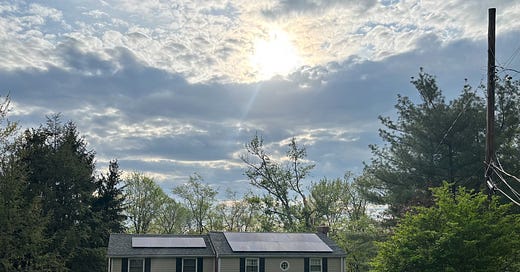The Humility to Hope
This week’s post is delayed.
Pittsburgh was hit by some impressive storms this week, and our house has been without power since. We are fortunate that nobody was injured, and the many trees that came down did no major structural damage to our home.
This post seemed timely, and the story is inspired by my experience during the first year of the COVID-19 pandemic.
Holding your hand, seeing your soul alive in your eyes, and hearing your voice for the first time, I thought to myself, “I cannot believe you are here.” When I met you, your lungs were ravaged by COVID-19 and bacterial pneumonia. I did not expect you to survive, let alone to walk, to talk, to hold your grandchild. I was so glad to be so wrong.
It was hard to imagine back then that today was a possibility. That you would leave the ICU with nurses, respiratory therapists, and physicians lining the halls, waving flags, and crying tears of joy. As you left through the double doors, a banner above your head proclaimed “Congratulations, COVID-19 Survivor!”
I first spoke to your daughter on a Saturday afternoon. You arrived overnight from another hospital, transferred to our facility after they told your family there was no hope.
“Your dad is deeply sedated, on maximal support from the ventilator.”
“Yes, the doctor told me last night.”
“We are doing everything we can to keep him alive.”
“I understand, doctor. My dad is very sick.” She was calm, but clearly understood the gravity, continuing, “We are praying for him, and for you all. We know we need a miracle.”
“Honestly...yes. Your dad needs excellent medical care from us, and we could use the help from above.”
Over the next month, the ICU doctors and nurses called your daughter to have more conversations like this one. In the beginning, the news was mostly bad. Always, your family held out hope and faith you would recover. They prayed for you, and for divine work through us. Over time, little by little, day by day, you got better. I know we provided excellent critical care, day in and out. But we provided the same care to so many patients who died during the pandemic. Good care was not enough.
As an intensivist caring for critically ill patients, I always hope that my patients survive. While I do not rely on miracles, I am increasingly humbled as I accrue years in practice as an attending intensivist. The interplay of hope and faith can be perplexing for people like me, who were not raised with and do not practice religion—“faith is being sure of what we hope for and certain of what we do not see” (Hebrews 11:1). This perspective on faith bumps up against another phrase, by which I live as an intensivist—trust, but verify.
During college and medical school, I learned to believe in cellular machinery invisible to the naked eye, but I did not do so on faith—it was verifiable through the scientific method. As a resident, I was trained to practice evidence-based medicine, applying data from the scientific literature to treat patients and provide them with a prognosis grounded in facts and numbers. When I encountered a patient or family holding out hope for a positive outcome, despite all evidence to the contrary, I instinctually labeled their faith as “irrational” or “unrealistic”. I perhaps reached my hope-killing zenith as a seasoned senior resident, seeing certainty where in retrospect it did not always exist. In meetings with patients and families, I often sought to impose reason on their feelings and faith.
My perspective has shifted, slowly, over a decade of practice. I have seen patients survive, who I expected to die; and patients who should walk out of the hospital die of unexpected catastrophe. These experiences are humbling, if I allow. As an intensivist, I seek to control as many variables as I can. My job is to anticipate and counter the myriad ways disease seeks to kill my patients. But people are not equations. I cannot control all variables, and the illusion of control is often just that—an illusion. I must accommodate space for the unexplained, the unexpected, the unknown. I strive to provide the key facts that patients and families need to make decisions, acknowledging uncertainty, and eliciting the preferences and values that inform what the “right” decision might be with the information at hand.
And I make room for hope.
And even miracles, like you.
I would like to thank my patient—who is still living years later—and his family, who both inspired this piece and reviewed and consented to my sharing it.





